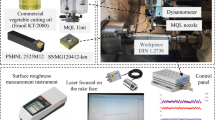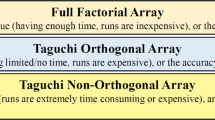Abstract
Material-cutting energy modeling is the key technology of energy modeling of machining process, being the foundation of energy optimization. The material-cutting power changes dynamically during variable-material removal rate (MRR) machining process. Hence, the energy characteristic of variable-MRR machining process is more complicated than that of constant-MRR machining process. In this paper, a modeling method of material-cutting energy for variable-MRR machining process is proposed. The dynamic power characteristics are fully considered in this method, and the impacts of cutting parameters on material-cutting energy are also considered. Experimental studies were conducted to obtain the fitting coefficients of the proposed energy model. Finally, energy calculations of four actual end face turning processes were performed. The results show that the predictive accuracy of all tested end face turning cases is above 90 %. The proposed method provides an accurate energy model for process planning in metal cutting process, which helps manufacturers determinate the energy-optimal process plan.
Similar content being viewed by others
References
Duflou JR, Sutherland JW, Dornfeld D, Herrmann C, Jeswiet J, Kara S, Hauschild M, Kellens K (2012) Towards energy and resource efficient manufacturing: a processes and systems approach. CIRP Ann - Manuf Technol 61(2):587–609
Calvanese ML, Albertelli P, Matta A, Taisch M (2013) Analysis of energy consumption in CNC machining centers and determination of optimal cutting conditions. In: Proceedings of 20th CIRP International Conference on Life Cycle Engineering, Singapore, pp 227–232.
Dahmus J, Gutowski T (2004) An environmental analysis of machining. 2004 ASME International Mechanical Engineering Congress and Exposition. ASME, Anaheim, CA, United states, pp 643–652
Mouzon G, Yildirim MB, Twomey J (2007) Operational methods for minimization of energy consumption of manufacturing equipment. Int J Prod Res 45(18–19):4247–4271
Rahimifard S, Seow Y, Childs T (2010) Minimising embodied product energy to support energy efficient manufacturing. CIRP Ann - Manuf Technol 59(1):25–28
International Energy Agency (IEA) (2007) Tracking industrial energy efficiency and CO2 emission. OECD/IEA, Paris
Rajemi MF, Mativenga PT, Aramcharoen A (2010) Sustainable machining: selection of optimum turning conditions based on minimum energy considerations. J Clean Prod 18(10–11):1059–1065
Yan J, Li L (2013) Multi-objective optimization of milling parameters—the trade-offs between energy, production rate and cutting quality. J Clean Prod 52:462–471
Bhushan RK (2013) Optimization of cutting parameters for minimizing power consumption and maximizing tool life during machining of Al alloy SiC particle composites. J Clean Prod 39:242–254
Li L, Yan J, Xing Z (2013) Energy requirements evaluation of milling machines based on thermal equilibrium and empirical modelling. J Clean Prod 52:113–121
Behrendt T, Zein A, Min S (2012) Development of an energy consumption monitoring procedure for machine tools. CIRP Ann - Manuf Technol 61(1):43–46
Diaz N, Redelsheimer E, Dornfeld D (2011) Energy consumption characterization and reduction strategies for milling machine tool use. In: Proceedings of the18th CIRP International Conference on Life Cycle Engineering., pp 263–267
Jia S, Tang RZ, Lv JX (2013) Therblig-based modeling methodology for cutting power and its application in external turning. Comp Integ Manuf Syst 19(5):1015–1024
Li W, Kara S (2011) An empirical model for predicting energy consumption of manufacturing processes: a case of turning process. Proc Inst Mech Eng B-J Eng Manuf 225(9):1636–1646
Zhang Y (2013) Energy efficiency techniques in machining process: a review. Int J Adv Manuf Technol 71(5–8):1123–32
Fysikopoulos A, Pastras G, Alexopoulos T, Chryssolouris G (2014) On a generalized approach to manufacturing energy efficiency. Int J Adv Manuf Technol 73(9–12):1437–52
Peng T, Xu X (2014) Energy-efficient machining systems: a critical review. Int J Adv Manuf Technol 72(9–12):1389–406
Ma J, Ge X, Chang SI, Lei S (2014) Assessment of cutting energy consumption and energy efficiency in machining of 4140 steel. Int J Adv Manuf Technol 74(9–12):1701–8
Wang X, Luo W, Zhang H, Dan B, Li F (2015) Energy consumption model and its simulation for manufacturing and remanufacturing systems. Int J Adv Manuf Technol. doi: 10.1007/s00170-015-7057-7
Gutowski T, Murphy C, Allen D, Bauer D, Bras B, Piwonka T, Sheng P, Sutherland J, Thurston D, Wollf E (2005) Environmentally benign manufacturing: observations from Japan, Europe and the United States. J Clean Prod 13(1):1–17
Gutowski T, Dahmus J, Thiriez A (2006) Electrical energy requirements for manufacturing processes. In: Proceedings of the 13th CIRP International Conference on Life Cycle Engineering, Leuven, May 31st-June 2nd, pp 623–627.
Kara S, Li W (2011) Unit process energy consumption models for material removal processes. CIRP Ann - Manuf Technol 60(1):37–40
Balogun VA, Mativenga PT (2013) Modelling of direct energy requirements in mechanical machining processes. J Clean Prod 41:179–186
Lv JX, Jia S, Tang RZ (2014) Therblig-based energy supply modeling of CNC machine tools. J Clean Prod 65:168–177
Dietmair A, Verl A (2009) A generic energy consumption model for decision making and energy efficiency optimization in manufacturing. Int J Sustain Eng 2(2):123–133
Dietmair A, Verl A (2009) Energy consumption forecasting and optimization for tool machines. Modern Machinery Sci J 3:62–67
Mori M, Fujishima M, Inamasu Y, Oda Y (2011) A study on energy efficiency improvement for machine tools. CIRP Ann - Manuf Technol 60(1):145–148
Avram OI, Xirouchakis P (2011) Evaluating the use phase energy requirements of a machine tool system. J Clean Prod 19(6–7):699–711
Avram O, Stroud I, Xirouchakis P (2011) A multi-criteria decision method for sustainability assessment of the use phase of machine tool systems. Int J Adv Manuf Technol 53(5–8):811–828
Liu F, Liu J, He Y (2009) Automatic collection method of machining progress information for large-size workpieces based on reference power curve. J Mech Eng 45(10):111–117
Hu S, Liu F, He Y, Hu T (2012) An on-line approach for energy efficiency monitoring of machine tools. J Clean Prod 27:133–140
Tristo G, Bissacco G, Lebar A, Valentinčič J (2015) Real time power consumption monitoring for energy efficiency analysis in micro EDM milling. Int J Adv Manuf Technol 78(9–12):1511–21
Li J, Lu Y, Zhao H, Li P, Yao Y (2013) Optimization of cutting parameters for energy saving. Int J Adv Manuf Technol 70(1–4):117–124
Wang Q, Liu F, Wang X (2013) Multi-objective optimization of machining parameters considering energy consumption. Int J Adv Manuf Technol 71(5–8):1133–1142
Campatelli G, Lorenzini L, Scippa A (2014) Optimization of process parameters using a response surface method for minimizing power consumption in the milling of carbon steel. J Clean Prod 66:309–316
Jia S, Tang RZ, Lv JX (2014) Therblig-based energy demand modeling methodology of machining process to support intelligent manufacturing. J Intell Manuf 25(5):913–931
Diaz N, Ninomiya K, Noble J, Dornfeld D (2012) Environmental impact characterization of milling and implications for potential energy savings in industry. Procedia CIRP 1:518–523
Bayoumi AE, Yücesan G, Hutton DV (1994) On the closed form mechanistic modeling of milling: specific cutting energy, torque and power. J Mater Eng Perform 3(1):151–158
Liu F, Xu ZJ, Dan B (1995) Energy characteristic of mechanical machining system and its application. China Machine Press, Beijing
Kordonowy DN (2002) A power assessment of machining tools, bachelor of science thesis in mechanical engineering. Massachusetts Institute of Technology, Cambridge, Massachusetts
Stute H, Limed EVD (1995) Transmissions and efficiencies for machine tools. Industrial indicator. 5–8
China Machinery Industry Federation (1997) Machining technology handbook. China Machine Press, Beijing
Ai X, Xiao SG (1994) Handbook of cutting parameters, 3rd edn. China Machine Press, Beijing
Camposeco-Negrete C (2013) Optimization of cutting parameters for minimizing energy consumption in turning of AISI 6061 T6 using Taguchi methodology and ANOVA. J Clean Prod 53:195–203
Jia S, Tang RZ, Lv JX (2014) Machining activity extraction and energy attributes inheritance method to support intelligent energy estimation of machining process. J Intell Manuf. doi: 10.1007/s10845-014-0894-7
Author information
Authors and Affiliations
Corresponding author
Rights and permissions
About this article
Cite this article
Jia, S., Tang, R., Lv, J. et al. Energy modeling for variable material removal rate machining process: an end face turning case. Int J Adv Manuf Technol 85, 2805–2818 (2016). https://doi.org/10.1007/s00170-015-8133-8
Received:
Accepted:
Published:
Issue Date:
DOI: https://doi.org/10.1007/s00170-015-8133-8




